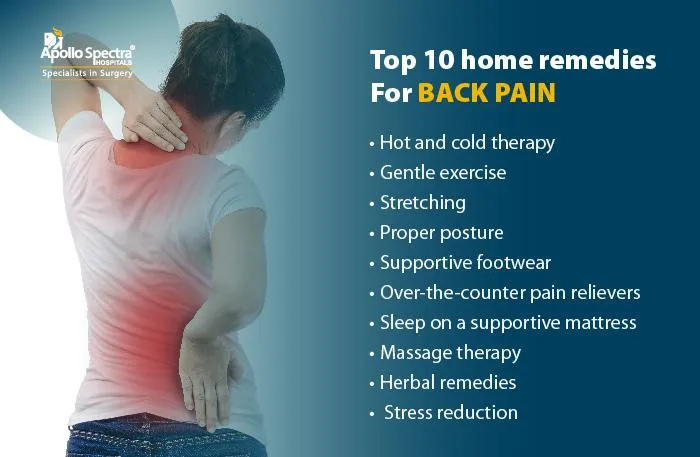
Back pain can interrupt daily life, making even simple activities uncomfortable. Luckily, there are home remedies that can offer quick relief without needing a prescription. In this blog, we’ll cover the top 10 remedies for back pain relief, including hot and cold packs, gentle stretching, massage, and products that can support your back health.
1. Hot and Cold Packs
Applying hot or cold packs is a simple yet effective way to alleviate back pain. Here’s how each can help:
- Cold Packs: Reduces inflammation and numbs sore tissues, which is particularly helpful right after an injury.
- Hot Packs: Improves blood flow to the affected area, promoting muscle relaxation and healing. This is best used for chronic pain or stiffness.
Tip: Apply a cold or hot pack for 15-20 minutes, several times a day. Always place a cloth between the pack and your skin to avoid burns or frostbite.
2. Gentle Stretching
Stretching is a natural way to relieve tension in the back muscles, increasing flexibility and reducing stiffness. A few effective stretches for back pain relief include:
- Cat-Cow Stretch: This yoga pose alternates between arching and rounding the spine, which can help release back tension.
- Child’s Pose: A gentle stretch that relaxes the lower back muscles and improves blood circulation.
Tip: Hold each stretch for 20-30 seconds, breathing deeply to enhance relaxation. Avoid any movements that cause pain.
3. Massage Therapy
Massaging the back muscles can reduce tension, improve circulation, and relieve pain. You can:
- Use a foam roller to gently roll out tight muscles in the lower back.
- Try a handheld massage device to target sore spots.
- Ask a friend or partner to give you a gentle massage or consider booking a professional massage.
Tip: For self-massage, use circular motions on the affected areas. Massage oils or creams with warming ingredients like menthol can enhance relief.
4. Stay Active with Light Exercises
While resting for a short period can help, staying active is crucial to avoiding muscle stiffness and weakness. Light exercises, such as walking or swimming, can improve blood flow and promote healing.
Tip: Try to keep your body moving without overexertion. Listen to your body and stop any activity that worsens pain.
5. Mindful Posture
Poor posture is a leading cause of back pain, especially for those who sit for extended periods. Improving your posture can prevent further strain on your back:
- Sit with your back straight, shoulders relaxed, and feet flat on the floor.
- Use a rolled-up towel or lumbar support pillow to support your lower back.
Tip: Adjust your workspace or home seating to ensure that your posture supports a healthy spine.
6. Epsom Salt Bath
Taking a warm bath with Epsom salts can be a soothing way to relax back muscles. Epsom salt contains magnesium, which can help relieve muscle soreness and reduce inflammation.
Tip: Dissolve two cups of Epsom salt in warm bathwater and soak for 15-20 minutes. The heat and magnesium work together to ease muscle tension.
7. Use Ergonomic Products
Ergonomic products, like supportive chairs and mattresses, can greatly improve back health by providing necessary support. Consider the following:
- Ergonomic Chair: Ideal for those who spend long hours sitting, ergonomic chairs support natural spine alignment.
- Memory Foam Pillows: These can help maintain proper alignment while sleeping.
Tip: A high-quality mattress and ergonomic accessories may require a one-time investment but can provide long-term comfort and back health.
8. Over-the-Counter (OTC) Pain Relief Creams
Topical creams and gels containing ingredients like menthol or capsaicin can provide temporary relief for back pain. These creams work by creating a warming or cooling sensation that helps distract from pain.
Tip: Apply the cream to the affected area as directed. Be careful not to use too much, as it can cause skin irritation.
9. Practice Deep Breathing and Relaxation Techniques
Stress and tension can contribute to back pain by causing muscles to tighten. Deep breathing exercises and relaxation techniques, such as progressive muscle relaxation, can help calm both the mind and the muscles.
- Deep Breathing: Focus on slow, deep breaths to release tension in the back and shoulders.
- Progressive Muscle Relaxation: This technique involves tensing and then relaxing different muscle groups, helping to release tightness in the back.
Tip: Spend a few minutes each day practicing these techniques to maintain a calm, relaxed body.
10. Try Over-the-Counter Pain Relievers When Needed
If back pain is limiting your daily activities, over-the-counter (OTC) medications like ibuprofen or acetaminophen can offer short-term relief. These anti-inflammatory drugs can reduce swelling and alleviate pain, making movement easier.
Tip: Follow dosage instructions carefully, and consult a healthcare professional if you need pain relief for more than a few days.
Conclusion
Back pain relief doesn’t always require a prescription or a doctor’s visit. By using these home remedies, you can take proactive steps to manage and reduce back pain effectively. Whether it’s hot and cold packs, gentle stretching, or investing in ergonomic products, there are multiple ways to find immediate relief and support long-term back health. However, if your pain persists or worsens, consider consulting a healthcare provider for personalized advice and treatment options.

